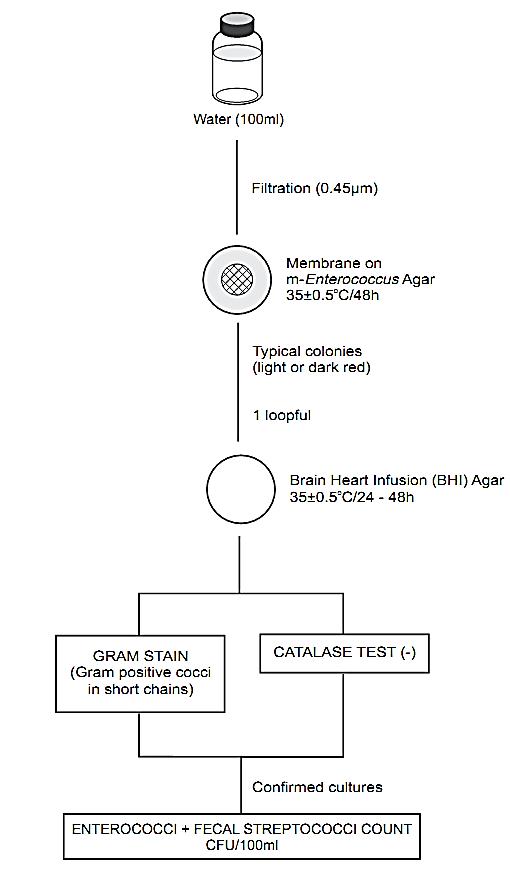
Membrane filtration method APHA/AWWA/WEF 2005 for enterococci and fecal streptococci in water
 المؤلف:
SILVA, N.D .; TANIWAKI, M.H. ; JUNQUEIRA, V.C.A.; SILVEIRA, N.F.A. , NASCIMENTO , M.D.D. and GOMES ,R.A.R
المؤلف:
SILVA, N.D .; TANIWAKI, M.H. ; JUNQUEIRA, V.C.A.; SILVEIRA, N.F.A. , NASCIMENTO , M.D.D. and GOMES ,R.A.R
 المصدر:
MICROBIOLOGICAL EXAMINATION METHODS OF FOOD AND WATE A Laboratory Manual
المصدر:
MICROBIOLOGICAL EXAMINATION METHODS OF FOOD AND WATE A Laboratory Manual
 الجزء والصفحة:
الجزء والصفحة:
 14-3-2016
14-3-2016
 3707
3707
Membrane filtration method APHA/AWWA/WEF 2005 for enterococci and fecal streptococci in water
Method described in the 21st Edition of the Standard Methods for the Examination of Water and Wastewater (Hunt & Rice, 2005).
1 - Material required for analysis
• Membrane filtration system
• Sterile membrane filter 0.45μm pore size
• Magnesium Chloride Phosphate Buffer (Dilution Water)
• M-Enterococcus Agar
• Brain Heart Infusion (BHI) Agar
• 3% Hydrogen Peroxide (for catalase test)
• Gram Stain Reagents
• Laboratory incubator set to 35 ± 0.5°C
2- Procedure
A general flowchart for the enumeration of enterococci and fecal streptococci using the membrane filtration method APHA/AWWA/WEF 2005 is shown in Figure 1.
a) Preparation of the sample and filtration: filter a suitable volume of the water sample through a sterile membrane filter of 0.45 μm pore size. The volume depends on the type of sample. For drinking water or bottled water 100 ml is the volume commonly used.
For polluted water the volume should be smaller. When filtering less than 10 ml, mix the sample with 10–100 ml of Magnesium Chloride Phosphate Buffer (Dilution Water) before filtration.
Note a.1) The sample volume should be adjusted to give no more than 200 colonies and 20 to 60 typical colonies on the membrane surface. If necessary, prepare and filter dilutions of the sample.
b) Incubation and colony counting: Transfer the membrane to a plate of m-Enterococcus Agar, avoiding air bubbles. Incubate the plates inverted at 35 ± 0.5°C/48 h. Select for counting the plates exhibiting a total number of colonies smaller than 200 and a number of typical colonies between 20 and 60. Count all light and dark red colonies as presumptive enterococci or fecal streptococci.
c) Confirmation: Pick five typical colonies from the membrane and streak onto the surface of Brain Heart Infusion (BHI) Agar. Incubate the BHI plates at 35 ± 0.5°C/24–48 h. Transfer a loopful of growth from a well-isolated colony to each of two clean glass slides. Use one slide to test for catalase production, adding a few drops of freshly prepared 3% Hydrogen Peroxide over the culture. The appearance of bubbles constitutes a positive catalase test and indicates that the colony is not a member of the enterococci or fecal streptococci groups. If the catalase test is negative (no bubbles), use the second glass slide to make a Gram stain of the culture.
Enterococci and fecal streptococci are cocci (ovoid cells) Gram positive, mostly in pairs or short chains.
d) Calculation of the result: Consider as enterococci or fecal streptococci the cocci Gram positive in pairs or short chains, catalase negative.
In normal situations, in which 100 ml of the sample are filtered, with the total number of colonies on the plate not exceeding 200 and the number of typical colonies falling within the recommended 20 to 60 range, the number of colony forming units (CFU)/100 ml sample is given directly by the formula: CFU/100 ml = (N° of typical colonies) × (number of colonies confirmed/number of colonies submitted to confirmation).
If a volume different from 100 ml was filtered, but the total number of colonies on the plate did not exceed 200 while the number of typical colonies nevertheless fell in the recommended range, the volume must be considered when calculating the result, reminding that, if dilutions were used, 1 ml of the 10−1 dilution corresponds to 0,1 ml of the original sample, 1 ml of the 10−2 dilution corresponds to 0.01 ml of the original sample and so forth. In this particular case, the number of CFU/100 ml is given by the following formula: CFU/100 ml = (N° of typical colonies) × (number of colonies confirmed/number of colonies submitted to con-firmation) × (100/volume of sample filtered).
If no typical colonies developed on any plate, express the result as absence or smaller than 1/filtered volume.
If none of the plates shows counts above 20 typical colonies, use the number obtained to calculate the result.
If the plates exhibit more than 60 typical colonies, proceed with counting provided that the total number of colonies on the plate does not exceed 200.
When the plate contains a number of colonies greater than 200, but it is still possible to count the number of typical colonies, count and use the number obtained in the calculations. Report the result as greater than or equal to (≥) the value obtained.
When the plate contains a number of colonies much greater than 200 an accurate counting is impossible. In this case report the result as presence or absence, depending on the presence of confirmed typical colonies.
Note d.1) The results obtained do not differentiate the members of the Enterococcus genus and the members of the Streptococcus .

Figure 1 Scheme of analysis for the enumeration of enterococci and fecal streptococci in water using the membrane filtration method APHA/AWWA/WEF 2005 (Hunt & Rice, 2005).
References
Silva, N.D .; Taniwaki, M.H. ; Junqueira, V.C.A.; Silveira, N.F.A. , Nasdcimento , M.D.D. and Gomes ,R.A.R .(2013) . Microbiological examination methods of food and water a laboratory Manual. Institute of Food Technology – ITAL, Campinas, SP, Brazil .
Hunt, M.E. & Rice, E.W. (2005) Microbiological examination. In: Eaton, A.D., Clesceri, L.S., Rice, E.W. & Greenberg, A.E. (eds). Standard Methods for the Examination of Water & Wastewater. 21st edition. Washington, American Public Health Association (APHA), American Water Works Association (AWWA) & Water Environment Federation (WEF). Part 9230, pp. 9.86–9.90.
 الاكثر قراءة في البكتيريا
الاكثر قراءة في البكتيريا
 اخر الاخبار
اخر الاخبار
اخبار العتبة العباسية المقدسة


